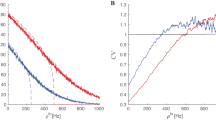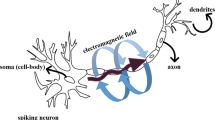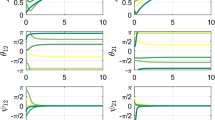Abstract
We study the dynamics and bifurcations of noise-free neurons coupled by gap junctions and inhibitory synapses, using both delayed delta functions and alpha functions to model the latter. We focus on the case of two cells, as in the studies of Chow and Kopell (2000) and Lewis and Rinzel (2003), but also show that stable asynchronous splay states exist for globally coupled networks of N cells dominated by subthreshold electrical coupling. Our results agree with those of Lewis and Rinzel (2003) in the weak coupling range, but our Poincaré map analysis yields more information about global behavior and domains of attraction, and we show that the explicit discontinuous maps derived using delayed delta functions compare well with the continuous history-dependent, implicitly-defined maps derived from alpha functions. We find that increased bias currents, super-threshold electrical coupling and synaptic delays promote synchrony, while sub-threshold electrical coupling and fast synapses promote asynchrony. We compare our analytical results with simulations of an ionic current model of spiking cells, and briefly discuss implications for stimulus response modes of locus coeruleus and for central pattern generators.
Similar content being viewed by others
References
Alvarez VA, Chow CC, Van Bockstaele EJ, Williams JT (2002) Frequency-dependent synchrony in locus coeruleus: role of electrotonic coupling. Proc. Natl. Acad. Sci. 99(6): 4032–4036.
Aston-Jones G, Cohen, JD (2005) An integrative theory of locus coeruleus norepinephrine function: adaptive gain and optimal performance. Ann. Rev. Neurosci. 28: 403–450.
Aston-Jones G, Rajkowski J, Kubiak P, Alexinsky T (1994) Locus coeruleus neurons in the monkey are selectively activated by attended stimuli in a vigilance task. J. Neurosci. 14: 4467–4480.
Bem T, Le Feuvre Y, Rinzel J, Meyrand P (2005) Electrical coupling induces bistability of rhythms in networks of inhibitory spiking neurones. Preprint, Laboratoire de Neurobiologe des Réseaux, Université de Bordeaux.
Bem T, Rinzel J (2004) Short duty cycle destabilizes a half-center oscillator, but gap junctions can restabilize the antiphase pattern. J. Neurophysiol. 91: 693–703.
Bressloff PC, Coombes S (2000) Dynamics of strongly coupled spiking neurons. Neural. Comp. 12: 91–129.
Brown E, Moehlis J, Holmes P, Clayton E, Rajkowski J, Aston-Jones G (2004) The influence of spike rate and stimulus duration on brainstem noradrenergic neurons. J. Comp. Neurosci. 17(1): 13–9.
Chillemi S, Panarese A, Barbi M, Di Garbo A (2005) Gap-junctions promote synchrony in a network of inhibitory interneurons in the presence of heterogeneities and noise. In: Mira J, Alvarez JR, eds. IWINAC 2005, Lecture Notes in Computer Science. Springer-Verlag, pp. 77–85.
Chow C (1998) Phase locking in weakly heterogeneous neuronal networks. Physica D 118: 343–370.
Chow CC, Kopell N (2000) Dynamics of spiking neurons with electrical coupling. Neural. Comp. 12: 1643–1678.
Clayton E, Rajkowski J, Cohen JD, Aston-Jones G (2004) Phasic activation of monkey locus coeruleus neurons by simple decisions in a forced choice task. J. Neurosci. 24: 99124–9920.
Connor J, Walter D, McKown R (1977) Neural repetitive firing: modifications of the Hodgkin-Huxley axon suggested by experimental results from crustacean axons. Biophys. J. 18: 81–102.
Cymbaluk GS, Nikolaev EV, Borisyuk RM (1994) In-phase and antiphase oscillations in a model of two electrically-coupled pacemakers. Biol. Cyb. 71: 153–160.
Gerstner W, van Hemmen JL, Cowan JD (1996) What matters in neuronal locking. Neural. Comp. 94: 1653–1676.
Golomb D, Rinzel J (1994) Clustering in globally-coupled inhibitory neurons. Physica D 72: 259–282.
Guckenheimer J, Holmes P (1983) Nonlinear oscillations, dynamical systems, and bifurcations of vector fields. Springer-Verlag.
Harris-Warrick RM, Marder E, Selverston AI, Moulins M (eds.) (1992) Dynamic biological networks: the stomatogastric nervous system. MIT Press.
Hopfield JJ, Herz AVM (2003) Rapid local synchronizaiton of action potentials: toward computaion with coupled integrate-and-fire neurons. Proc. Natl. Acad. USA 92: 6655–6662.
Hoppensteadt FC, Izhikevich E (1997) Weakly connected neural networks. Springer-Verlag.
Kopell N, Ermentrout GB (2004) Chemical and electrical synapses perform complementary roles in the synchronization of interneuronal networks. Proc. Nat. Acad. Sci. 101(43): 15482–15487.
Lewis TJ (2003) Phase locking in electrically-coupled non-leaky integrate-and-fire neurons. Discrete and Continuous Dynamical Systems, Supplementary volume, Proc. 4th Int. Conf. on Dynamical Systems and Differential Equations. pp. 554–562.
Lewis TJ, Rinzel J (2003) Dynamics of spiking neurons connected by both inhibitory and electrical coupling. J. Comp. Neurosci. 14: 283–309.
Marder E (1984) Roles for electrical coupling in neural circuits as revealed by selective neuronal detections. J. Exp. Biol. 112: 147–167.
Merriam EB, Nethoff TI, Banks MI (2005) Bistable network behavior of layer I interneurons in auditory cortex. J. Neurosci. 25(2): 6175–6186.
Mirollo RE, Strogatz SH (1990) Synchronization of pulse-coupled biological oscillators. SIAM J. Appl. Math. 50: 1645–1662.
Nusbaum MP, Beenhakker MP (2002) A small-systems approach to motor pattern generation. Nature 417: 343–350.
Pfeuty B, Mato G, Golomb D, Hansel D (2003) Electrical synapses and synchrony: the role of intrinsic currents. J. Neurosci. 23: 6280–6294.
Pfeuty B, Mato G, Golomb D, Hansel D (2005) The combined effects of inhibitory and electrical synapses on synchrony. Neural. Comp. 17: 633–670.
Rose R, Hindmarsh J (1989) The assembly of ionic currents in a thalamic neuron I. The three-dimensional model. Proc. R. Soc. Lond. B 237: 267–288.
Rowat PF, Selverston AI (1997) Oscillatory mechanisms in pairs of neurons connected with fast inhibitory synapses. J. Comp. Neurosci. 4: 103–127.
Shadlen MN, Movshon JA (1999) Synchrony unbound: a critical evaluation of the temporal binding hypothesis. Neuron. 24: 67–77.
Singer W (1999) Neuronal synchrony: a versatile code for the definition of relations. J. Comp. Neurosci. 24: 49–65.
Usher M, Cohen JD, Servan-Schreiber D, Rajkowsky J, Aston-Jones G (1999) The role of locus coeruleus in the regulation of cognitive performance. Science 283: 549–554.
Van Vreeswijk C, Abbott LF, Ermentrout GB (1994) When inhibition not excitation synchronizes neural firing. J. Comp. Neurosci. 1: 313–321.
Wang XJ, Buzsáki G (1996) Gamma oscillation by synaptic inhibition in a hippocampal interneuronal network model. J. Neurosci. 16: 6402–6413.
Author information
Authors and Affiliations
Corresponding author
Additional information
Action Editor: F. Skinner
Rights and permissions
About this article
Cite this article
Gao, J., Holmes, P. On the dynamics of electrically-coupled neurons with inhibitory synapses. J Comput Neurosci 22, 39–61 (2007). https://doi.org/10.1007/s10827-006-9676-3
Received:
Revised:
Accepted:
Published:
Issue Date:
DOI: https://doi.org/10.1007/s10827-006-9676-3




